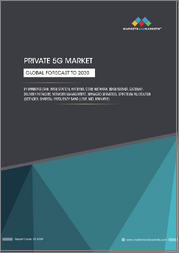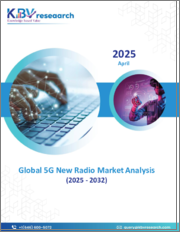
|
시장보고서
상품코드
1453964
세계의 프라이빗 무선 시장 예측(-2030년) : 부문별 분석Private Wireless Market Forecasts to 2030 - Global Analysis By Component (Hardware and Software), By Deployment Type (On-premises and Cloud-based), Organization Size, Technology, Application and By Geography |
||||||
세계의 프라이빗 무선(Private Wireless) 시장은 2023년에 50억 3,000만 달러였으며, 예측 기간 중 CAGR은 21.5%로 추이하며 성장 할 것으로 예상되며, 2030년에는 196억 9,000만 달러에 달할 것으로 예측되고 있습니다.
프라이빗 무선이란 조직이 현장 또는 사업장 내에서 독점적으로 사용하기 위해 배포하는 전용 무선 네트워크입니다. 면허 또는 면허가 없는 주파수 대역을 활용하는 프라이빗 무선 네트워크는 산업 자동화, 물류, 스마트 인프라 등 중요한 용도에 안전하고 안정적이며 고성능 연결성을 제공합니다. 이러한 네트워크는 특정 요구 사항에 맞게 사용자 지정할 수 있으며 통신 리소스의 제어성을 높일 수 있습니다.
산업정보화성에 따르면 중국에서는 지난해 60만 개가 넘는 5G 기지국 건설이 예상되었습니다.
안전하고 안정적인 연결성에 대한 수요 증가
제조업, 헬스케어, 운송 등 다양한 산업의 조직은 중요한 업무 및 용도을 지원하기 위해 견고한 통신 네트워크가 필요합니다. 프라이빗 무선 네트워크는 전용 주파수 대역, 향상된 보안 기능, 높은 신뢰성 등 이점을 제공하며, 이러한 업계의 엄격한 연결 요구 사항을 충족합니다. 안전하고 신뢰할 수 있는 커뮤니케이션에 대한 요구 증가는 프라이빗 무선 솔루션의 세계 보급을 뒷받침하고 있습니다.
표준화 부족
보편적으로 받아들여지는 기술 사양이나 상호 운용성 표준이 없기 때문에 프라이빗 무선 네트워크의 배포는 단편적이고 복잡해집니다. 이 표준화의 부족은 기존 인프라와 원활한 통합, 서로 다른 네트워크 구성 요소 간의 상호 운용성, 다중 공급업체 장치와 호환성을 방해합니다. 또한 기업에 불확실성을 가져와 규모의 경제를 저해함으로써 기술 혁신을 방해하고 시장 성장을 저해하고 있습니다.
사물인터넷(IoT) 채택 확대
프라이빗 무선 네트워크는 다양한 산업에서 IoT 배포를 지원하는 데 필요한 견고하고 안정적인 연결성을 제공합니다. 이러한 네트워크는 IoT 장치, 센서 및 시스템 간의 원활한 통신을 가능하게 하여 데이터 수집, 분석 및 자동화를 촉진합니다. 업무 효율성 향상, 안전성 강화, 디지털 변환을 실현하는 IoT 주도형 솔루션에 대한 수요가 높아지는 가운데 프라이빗 무선 네트워크는 IoT 구현을 가능하게 하는데 중요한 역할을 하고 있습니다.
사이버 보안 문제
사이버 보안 문제는 프라이빗 무선 시장에 심각한 위협이 되고 있습니다. 중요한 업무에 프라이빗 무선 네트워크에 점점 더 의존하는 조직이 늘어나면서 사이버 공격의 표적이 되고 있습니다. 이러한 위협에는 멀웨어, 랜섬웨어, 무단 액세스, 데이터 유출 등이 포함됩니다. 개인 무선 네트워크에 대한 사이버 공격이 성공하면 운영이 중단되고 민감한 정보가 유출되며 금전적 손실이나 평판 손상이 발생할 수 있습니다. 또한, 개인 네트워크에 연결된 디바이스가 급증하면서 공격 표면이 확대되어 사이버 위협에 더욱 취약해집니다.
COVID-19의 영향 :
COVID-19의 팬데믹은 원격 근무, 온라인 교육 및 가상 커뮤니케이션으로 인한 연결 수요 증가로 인해 공중 휴대폰 네트워크에 영향을 미쳤습니다. 이 이용자의 급증은 네트워크 용량을 압박해 일부 지역에서는 혼잡과 인터넷 속도의 저하를 초래했습니다. 또한 공급망의 혼란이 인프라 업그레이드와 5G 배포를 지연시켰습니다. 그러나 통신 제공업체는 유통시 신뢰할 수 있는 연결에 대한 수요 증가에 대응하기 위해 네트워크 확장 및 강화에 투자함으로써 대응했습니다.
예측기간 동안 소프트웨어부문이 최대화될 전망
공중 셀룰러 네트워크 시장에서는 예측 기간 동안 소프트웨어 부문이 최대가 될 것으로 예측됩니다. 이러한 성장을 추구하는 것은 소프트웨어 정의 네트워킹(SDN)과 네트워크 기능 가상화(NFV) 기술의 채택 확대입니다. 이러한 소프트웨어 기반 솔루션은 유연하고 확장 가능한 네트워크 아키텍처를 가능하게 하여 효율적인 리소스 할당, 네트워크 관리 및 서비스 제공을 촉진합니다. 또한 소프트웨어 솔루션은 네트워크 슬라이싱 및 에지 컴퓨팅과 같은 고급 기능을 실현하는 데 중요한 역할을 하며 시장에서 이점을 높입니다.
예측 기간 동안 CAGR이 가장 높을 것으로 예측되는 중소기업(SME) 부문
예측 기간 동안 공중 셀룰러 네트워크 시장은 중소기업(SME) 부문의 연간 평균 성장률이 가장 높을 것으로 예측됩니다. 이러한 성장은 클라우드 기반 서비스, IoT 배포, 모바일 워크포스 활성화 등 다양한 용도로 중소기업 간의 셀룰러 연결 채택이 진행되고 있기 때문입니다. 또한 기술 진보와 중소기업 특유 수요에 대응한 저렴한 솔루션을 이용할 수 있게 된 것도 공중 셀룰러 네트워크의 급속한 보급에 기여하고 있습니다.
최대 점유율을 차지하는 지역 :
북미는 첨단 통신 인프라, 디지털 기술의 광범위한 도입, 다양한 산업에서 사설 네트워크의 대규모 배포로 프라이빗 무선 시장을 독점하는 입장에 있습니다. 또한 북미에는 프라이빗 무선 분야의 주요 기업와 혁신자가 많이 존재하며, 기술 혁신을 추진하고 업계 표준을 설정하고 있습니다. 이러한 요인은 종합적으로 프라이빗 무선 시장에서 북미의 리더십에 기여하고 있습니다.
CAGR이 가장 높은 지역 :
아시아태평양은 급속한 경제 발전, 산업화의 진전, 디지털화에 대한 노력 증가로 신뢰성이 높고 안전한 통신 네트워크에 대한 수요가 높아지고 있어 프라이빗 무선 시장에서 유리한 성장이 전망되고 있습니다. 또한 스마트 시티 프로젝트, Industry 4.0 구현, 농촌 연결 프로그램 등 노력이 프라이빗 무선 솔루션의 채택을 더욱 강화하고 있습니다. 대규모로 다양한 시장을 보유한 아시아태평양은 프라이빗 무선 벤더들에게 존재와 사업 확대의 큰 기회가 될 것입니다.
무료 맞춤 서비스 :
이 보고서를 구독하는 고객은 다음 무료 맞춤설정 옵션 중 하나를 사용할 수 있습니다.
- 기업 프로파일
- 추가 시장 기업의 종합적 프로파일링(3개사까지)
- 주요 기업의 SWOT 분석(3개사까지)
- 지역 세분화
- 고객 관심 기반 주요 국가 시장 추정 및 예측·CAGR(주 : 타당성 확인에 따름)
- 경쟁 벤치마킹
- 제품 포트폴리오, 지리적 존재, 전략적 제휴에 기반한 주요 기업 벤치마킹
목차
제1장 주요 요약
제2장 서문
- 개요
- 이해관계자
- 조사 범위
- 조사 방법
- 데이터 마이닝
- 데이터 분석
- 데이터 검증
- 조사 접근
- 조사 소스
- 1차 조사 소스
- 2차 조사 소스
- 전제조건
제3장 시장 동향 분석
- 성장 촉진요인
- 억제요인
- 기회
- 위협
- 기술 분석
- 용도 분석
- 신흥 시장
- COVID-19의 영향
제4장 Porter's Five Forces 분석
- 공급기업의 협상력
- 구매자의 협상력
- 대체품의 위협
- 신규 진입업자의 위협
- 경쟁 기업간 경쟁 관계
제5장 세계의 프라이빗 무선 시장 : 컴포넌트별
- 하드웨어
- 기지국
- 안테나
- 라우터
- 스위치
- 기타 하드웨어
- 소프트웨어
- 네트워크 관리 소프트웨어
- 보안 솔루션
- 기타 소프트웨어
제6장 세계의 프라이빗 무선 시장 : 전개 유형별
- 온프레미스
- 클라우드 기반
제7장 세계의 프라이빗 무선 시장 : 조직 규모별
- 중소기업(SME)
- 대기업
제8장 세계의 프라이빗 무선 시장 : 기술별
- LTE
- 5G
- Wi-Fi
- 기타 기술
제9장 세계의 프라이빗 무선 시장 : 용도별
- 제조업
- 헬스케어
- 운송 및 물류
- 에너지 및 유틸리티
- 긴급 서비스
- 기타 용도
제10장 세계의 프라이빗 무선 시장 : 지역별
- 북미
- 미국
- 캐나다
- 멕시코
- 유럽
- 독일
- 영국
- 이탈리아
- 프랑스
- 스페인
- 기타 유럽
- 아시아태평양
- 일본
- 중국
- 인도
- 호주
- 뉴질랜드
- 한국
- 기타 아시아태평양
- 남미
- 아르헨티나
- 브라질
- 칠레
- 기타 남미
- 중동 및 아프리카
- 사우디아라비아
- 아랍에미리트(UAE)
- 카타르
- 남아프리카
- 기타 중동 및 아프리카
제11장 주요 발전
- 계약/파트너십/협업/합작투자(JV)
- 인수와 합병
- 신제품 발매
- 사업 확대
- 기타 주요 전략
제12장 기업 프로파일
- Advantech Co., Ltd.
- Belden Inc.
- Bharti Airtel Limited
- Cambium Networks Corporation
- Cisco Systems, Inc.
- CommScope Holding Company, Inc.
- Cradlepoint, Inc.
- Ericsson AB
- Harris Corporation
- Huawei Technologies Co., Ltd.
- Jio
- Juniper Networks, Inc.
- L3Harris Technologies, Inc.
- Ligado Networks LLC
- NEC Corporation
- Nokia Corporation
- Qualcomm Incorporated
- Siemens AG
- Syniverse
- Telit Communications PLC
- Thales Group
- Ubiquiti Inc.
- Verizon Communications
- Vodafone Group plc
- ZTE Corporation
According to Stratistics MRC, the Global Private Wireless Market is accounted for $5.03 billion in 2023 and is expected to reach $19.69 billion by 2030 growing at a CAGR of 21.5% during the forecast period. Private wireless is a dedicated wireless network deployed by an organization for exclusive use within its premises or operations. Utilizing licensed or unlicensed spectrum, private wireless networks offer secure, reliable, and high-performance connectivity for critical applications such as industrial automation, logistics, and smart infrastructure. These networks can be customized to meet specific requirements and provide greater control over communication resources.
According to the Ministry of Industry and Information Technology, China expected to build over 600,000 5G base stations last year.
Market Dynamics:
Driver:
Increasing demand for secure and reliable connectivity
Organizations across various industries, such as manufacturing, healthcare, and transportation, require robust communication networks to support critical operations and applications. Private wireless networks offer advantages such as dedicated spectrum, enhanced security features, and high reliability, meeting the stringent connectivity requirements of these industries. This growing need for secure and dependable communication drives the adoption of private wireless solutions worldwide.
Restraint:
Lack of standardization
Without universally accepted technical specifications and interoperability standards, the deployment of private wireless networks becomes fragmented and complex. This lack of standardization impedes seamless integration with existing infrastructure, interoperability between different network components, and compatibility with devices from multiple vendors. Moreover, it hampers innovation and stifles market growth by creating uncertainties for businesses and hindering economies of scale.
Opportunity:
Growing adoption of the Internet of Things (IoT)
Private wireless networks provide the robust and reliable connectivity needed to support IoT deployments across various industries. These networks enable seamless communication between IoT devices, sensors, and systems, facilitating data collection, analysis, and automation. With the increasing demand for IoT-driven solutions to improve operational efficiency, enhance safety, and enable digital transformation, private wireless networks play a crucial role in enabling IoT implementations.
Threat:
Cybersecurity Issues
Cybersecurity issues represent a significant threat to the private wireless market. As organizations increasingly rely on private wireless networks for critical operations, they become targets for cyberattacks. These threats include malware, ransomware, unauthorized access, and data breaches. A successful cyberattack on a private wireless network can disrupt operations, compromise sensitive information, and lead to financial losses or reputational damage. Additionally, the proliferation of connected devices in private networks expands the attack surface, making them more vulnerable to cyber threats.
Covid-19 Impact:
The COVID-19 pandemic has impacted public cellular networks by increasing demand for connectivity due to remote work, online education, and virtual communication. This surge in usage strained network capacities, leading to congestion and slower internet speeds in some areas. Additionally, supply chain disruptions delayed infrastructure upgrades and 5G deployments. However, telecommunications providers adapted by investing in network expansions and enhancements to meet the heightened demand for reliable connectivity during the pandemic.
The software segment is expected to be the largest during the forecast period
In the public cellular networks market, the software segment is projected to emerge as the largest during the forecast period. This growth is driven by the increasing adoption of software-defined networking (SDN) and network function virtualization (NFV) technologies. These software-based solutions enable flexible and scalable network architectures, facilitating efficient resource allocation, network management, and service delivery. Moreover, software solutions play a crucial role in enabling advanced features such as network slicing and edge computing, driving their dominance in the market.
The small and medium-sized enterprises (SMEs) segment is expected to have the highest CAGR during the forecast period
The small and medium-sized enterprises (SMEs) segment is anticipated to experience the highest compound annual growth rate in the public cellular networks market during the forecast period. This growth can be attributed to the increasing adoption of cellular connectivity among SMEs for various applications such as cloud-based services, IoT deployments, and mobile workforce enablement. Additionally, advancements in technology and the availability of affordable solutions catered to the specific needs of SMEs contribute to their rapid adoption of public cellular networks.
Region with largest share:
The North American region is positioned to dominate the private wireless market due to the region's advanced telecommunications infrastructure, extensive adoption of digital technologies, and large-scale deployments of private networks in various industries. Moreover, North America is home to numerous key players and innovators in the private wireless space, driving innovation and setting industry standards. These factors collectively contribute to North America's leadership in the private wireless market.
Region with highest CAGR:
Asia Pacific is poised for lucrative growth in the private wireless market owing to the region's rapid economic development, expanding industrialization, and increasing digitization efforts, which are driving the demand for reliable and secure communication networks. Additionally, initiatives such as smart city projects, Industry 4.0 implementations, and rural connectivity programs further boost the adoption of private wireless solutions. With a large and diverse market, Asia Pacific presents significant opportunities for private wireless vendors to expand their presence and operations.
Key players in the market
Some of the key players in Private Wireless Market include Advantech Co., Ltd., Belden Inc., Bharti Airtel Limited, Cambium Networks Corporation, Cisco Systems, Inc., CommScope Holding Company, Inc., Cradlepoint, Inc., Ericsson AB, Harris Corporation, Huawei Technologies Co., Ltd., Jio, Juniper Networks, Inc., L3Harris Technologies, Inc., Ligado Networks LLC, NEC Corporation, Nokia Corporation, Qualcomm Incorporated, Siemens AG, Syniverse, Telit Communications PLC, Thales Group, Ubiquiti Inc., Verizon Communications, Vodafone Group plc and ZTE Corporation.
Key Developments:
In September 2023, Verizon Business announced a five-year partnership deal with the National Football League (NFL) to deliver a Managed Private Wireless Solution across each of the 30 U.S. NFL stadiums. This solution includes full support for coach-to-coach communications on the field and provides the NFL with speed, security and reliability for critical on field coach-to-coach communication.
In August 2023, Syniverse, "the world's most connected company,"(R) has received a 2023 IoT Evolution Private Wireless Network Innovation Award from IoT Evolution World, the leading publication covering Internet of Things (IoT) technologies, for its Private Wireless Network solution.
Components Covered:
- Hardware
- Software
Deployment Types Covered:
- On-premises
- Cloud-based
Organization Sizes Covered:
- Small and Medium-sized Enterprises (SMEs)
- Large Enterprises
Technologies Covered:
- LTE
- 5G
- Wi-Fi
- Other Technologies
Applications Covered:
- Manufacturing
- Healthcare
- Transportation and Logistics
- Energy and Utilities
- Emergency Services
- Other Applications
Regions Covered:
- North America
- US
- Canada
- Mexico
- Europe
- Germany
- UK
- Italy
- France
- Spain
- Rest of Europe
- Asia Pacific
- Japan
- China
- India
- Australia
- New Zealand
- South Korea
- Rest of Asia Pacific
- South America
- Argentina
- Brazil
- Chile
- Rest of South America
- Middle East & Africa
- Saudi Arabia
- UAE
- Qatar
- South Africa
- Rest of Middle East & Africa
What our report offers:
- Market share assessments for the regional and country-level segments
- Strategic recommendations for the new entrants
- Covers Market data for the years 2021, 2022, 2023, 2026, and 2030
- Market Trends (Drivers, Constraints, Opportunities, Threats, Challenges, Investment Opportunities, and recommendations)
- Strategic recommendations in key business segments based on the market estimations
- Competitive landscaping mapping the key common trends
- Company profiling with detailed strategies, financials, and recent developments
- Supply chain trends mapping the latest technological advancements
Free Customization Offerings:
All the customers of this report will be entitled to receive one of the following free customization options:
- Company Profiling
- Comprehensive profiling of additional market players (up to 3)
- SWOT Analysis of key players (up to 3)
- Regional Segmentation
- Market estimations, Forecasts and CAGR of any prominent country as per the client's interest (Note: Depends on feasibility check)
- Competitive Benchmarking
- Benchmarking of key players based on product portfolio, geographical presence, and strategic alliances
Table of Contents
1 Executive Summary
2 Preface
- 2.1 Abstract
- 2.2 Stake Holders
- 2.3 Research Scope
- 2.4 Research Methodology
- 2.4.1 Data Mining
- 2.4.2 Data Analysis
- 2.4.3 Data Validation
- 2.4.4 Research Approach
- 2.5 Research Sources
- 2.5.1 Primary Research Sources
- 2.5.2 Secondary Research Sources
- 2.5.3 Assumptions
3 Market Trend Analysis
- 3.1 Introduction
- 3.2 Drivers
- 3.3 Restraints
- 3.4 Opportunities
- 3.5 Threats
- 3.6 Technology Analysis
- 3.7 Application Analysis
- 3.8 Emerging Markets
- 3.9 Impact of Covid-19
4 Porters Five Force Analysis
- 4.1 Bargaining power of suppliers
- 4.2 Bargaining power of buyers
- 4.3 Threat of substitutes
- 4.4 Threat of new entrants
- 4.5 Competitive rivalry
5 Global Private Wireless Market, By Component
- 5.1 Introduction
- 5.2 Hardware
- 5.2.1 Base Stations
- 5.2.2 Antennas
- 5.2.3 Routers
- 5.2.4 Switches
- 5.2.5 Other Hardware
- 5.3 Software
- 5.3.1 Network Management Software
- 5.3.2 Security Solutions
- 5.3.3 Other Software
6 Global Private Wireless Market, By Deployment Type
- 6.1 Introduction
- 6.2 On-premises
- 6.3 Cloud-based
7 Global Private Wireless Market, By Organization Size
- 7.1 Introduction
- 7.2 Small and Medium-sized Enterprises (SMEs)
- 7.3 Large Enterprises
8 Global Private Wireless Market, By Technology
- 8.1 Introduction
- 8.2 LTE
- 8.3 5G
- 8.4 Wi-Fi
- 8.5 Other Technologies
9 Global Private Wireless Market, By Application
- 9.1 Introduction
- 9.2 Manufacturing
- 9.3 Healthcare
- 9.4 Transportation and Logistics
- 9.5 Energy and Utilities
- 9.6 Emergency Services
- 9.7 Other Applications
10 Global Private Wireless Market, By Geography
- 10.1 Introduction
- 10.2 North America
- 10.2.1 US
- 10.2.2 Canada
- 10.2.3 Mexico
- 10.3 Europe
- 10.3.1 Germany
- 10.3.2 UK
- 10.3.3 Italy
- 10.3.4 France
- 10.3.5 Spain
- 10.3.6 Rest of Europe
- 10.4 Asia Pacific
- 10.4.1 Japan
- 10.4.2 China
- 10.4.3 India
- 10.4.4 Australia
- 10.4.5 New Zealand
- 10.4.6 South Korea
- 10.4.7 Rest of Asia Pacific
- 10.5 South America
- 10.5.1 Argentina
- 10.5.2 Brazil
- 10.5.3 Chile
- 10.5.4 Rest of South America
- 10.6 Middle East & Africa
- 10.6.1 Saudi Arabia
- 10.6.2 UAE
- 10.6.3 Qatar
- 10.6.4 South Africa
- 10.6.5 Rest of Middle East & Africa
11 Key Developments
- 11.1 Agreements, Partnerships, Collaborations and Joint Ventures
- 11.2 Acquisitions & Mergers
- 11.3 New Product Launch
- 11.4 Expansions
- 11.5 Other Key Strategies
12 Company Profiling
- 12.1 Advantech Co., Ltd.
- 12.2 Belden Inc.
- 12.3 Bharti Airtel Limited
- 12.4 Cambium Networks Corporation
- 12.5 Cisco Systems, Inc.
- 12.6 CommScope Holding Company, Inc.
- 12.7 Cradlepoint, Inc.
- 12.8 Ericsson AB
- 12.9 Harris Corporation
- 12.10 Huawei Technologies Co., Ltd.
- 12.11 Jio
- 12.12 Juniper Networks, Inc.
- 12.13 L3Harris Technologies, Inc.
- 12.14 Ligado Networks LLC
- 12.15 NEC Corporation
- 12.16 Nokia Corporation
- 12.17 Qualcomm Incorporated
- 12.18 Siemens AG
- 12.19 Syniverse
- 12.20 Telit Communications PLC
- 12.21 Thales Group
- 12.22 Ubiquiti Inc.
- 12.23 Verizon Communications
- 12.24 Vodafone Group plc
- 12.25 ZTE Corporation



















